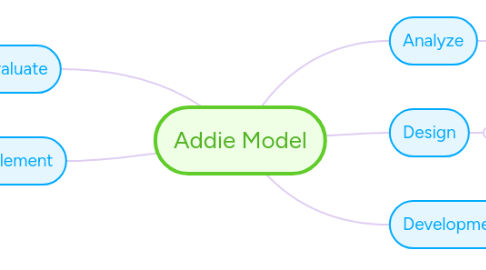
1. Evaluate
1.1. Formative Assessment
1.1.1. checkpoints
1.2. Summative Assessment
1.2.1. final assessment
1.3. technology
1.3.1. SMART Response
1.3.2. Turning Point
1.3.3. Google Forms
1.3.4. Socrative
2. Implement
3. Analyze
3.1. Conduct needs assessment
3.2. Access relevant learner characteristics/learner analysis
3.2.1. interests
3.2.2. age
3.2.3. languages/ELL
3.2.4. background knowledge/funds of knowledge
3.2.5. attitude about my subject
3.2.6. learning styles
3.2.7. culture
3.2.8. services
3.2.8.1. accommodations for IEP/504
3.2.8.2. psych, social, legal
3.2.8.3. FARMS
3.2.9. demographics
3.2.10. relationships
3.2.10.1. changing
3.2.10.2. friends
3.2.11. interpersonal skill
3.2.12. home/environment issues
3.2.13. favorite subjects
3.3. Content/Task/Work Analysis
3.3.1. self-assess on content knowledge
3.3.2. standards
3.3.3. internet research
3.3.3.1. content gaps
3.3.3.2. materials
3.3.3.3. activities
3.3.4. district/state mandates
3.3.5. curricular materials and people at school
3.3.6. synthesize/organize/weed/select/sequence
3.4. Front End Analysis
3.5. Context/Resource Analysis
3.5.1. Technology
3.5.2. Money
3.5.3. Parental/community involvement
3.5.4. textbooks/curriculum materials
3.5.5. physical space/building
3.5.6. speckailists
3.5.7. teacher to student ratio
3.5.8. administrators
3.5.9. other teachers
3.5.10. additional services
3.5.10.1. academic
3.5.10.2. disciplinary
3.5.11. transportation
3.5.12. geographic opportunities
3.5.13. students
3.5.14. staff
3.6. Affective Analysis
4. Design
4.1. Writing Objectives: ABCD Model
4.1.1. Audience
4.1.1.1. intended learner
4.1.1.2. SWBAT - Students Will Be Able To
4.1.2. Behavior
4.1.2.1. cognitive - thinking
4.1.2.1.1. remembering or reproducing
4.1.2.2. affective - emotional
4.1.2.2.1. attitudes and values
4.1.2.3. psychomotor - physical
4.1.2.3.1. muscular motor skill, manipulation of material
4.1.2.4. interpersonal
4.1.2.5. must be observable and measurable
4.1.2.6. Bloom's Taxonomy
4.1.2.6.1. Hess's Cognitive Rigor Matrix
4.1.3. Condition
4.1.3.1. equipment or tools that can be used
4.1.4. Degree
4.1.4.1. standard for acceptable performance
4.2. Terminal Objectives
4.2.1. what students will know or be able to do at the end of the unit/lesson
4.3. Enabling Objectives
4.3.1. the component skills and knowledge that enable the learner to reach the terminal goal
4.4. Essential Question
4.4.1. Why
4.4.1.1. connects 2 nouns
4.4.2. How
4.4.3. based on broad concepts
4.4.4. answered differently based on personal viewpoins & perspectives
4.5. Enduring Understanding
4.5.1. 2 or more concepts combined to make a relationship
4.5.2. no proper/personal nouns
4.5.3. no past/past perfect/present perfect
4.6. Standards
5. Development
5.1. make assessments
5.2. prepare technology
5.3. implementation plan
5.4. Gagne's 9 Events of Learning
5.4.1. gain attention
5.4.2. inform learners of objectives
5.4.3. stimulate recall of prior learning
5.4.4. present the content
5.4.5. provide guidance
5.4.6. elicit performance
5.4.7. provide feedback
5.4.8. assess performance
5.4.9. enhance retention and transfer
5.5. Gradual Release of Responsibility Model
5.5.1. I do it
5.5.2. We do it
5.5.3. You do it independently
5.5.4. You do it together
5.6. Ubd = Understand by Design (Backwards Design)
5.6.1. WHERETO
5.6.1.1. Where
5.6.1.2. Hook
5.6.1.3. Equip & Experience
5.6.1.4. Rethink
5.6.1.5. Evaluate
5.6.1.6. Tailor
5.6.1.7. Organize
5.7. UDL = Universal Design for Learning
5.7.1. Representation
5.7.2. Action and Expression
5.7.3. Engagement
5.8. Differentiation
5.8.1. looking at different needs and tweaking based on that
5.8.2. Content
5.8.3. Process
5.8.4. Product
5.8.5. Environment
5.9. Assistive Technology
5.9.1. any tool give to your students that give them access to the curriculum/learning

